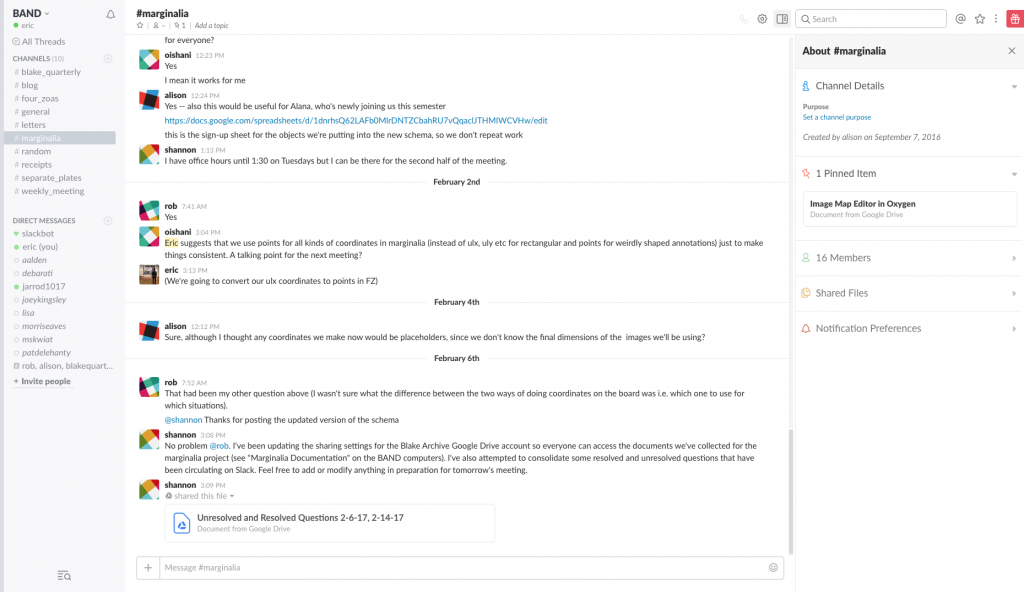In the fall, BAND (our group in Rochester) decided to try out the Slack app.
Growing group numbers and starting more complicated and diverse projects led us to try out a communication platform that was built to handle such dynamic work environments. It was/is an experiment, and I promised to check back after a semester to reflect on how the experiment was going. Here’s my report:
Pros
- Organizing Slack “channels” by project has been incredibly useful in keeping track of conversations and progress. Each channel developed its own tone and style, too. The marginalia group channel is usually lively, often with people sharing notes or asking questions. The channel for the commercial plates transcriptions is mostly used for organization, as the transcriptions for that project are pretty straightforward, but it can be challenging keeping track of the many files coming and going.
- Google Drive integration combined with the “pin” feature in Slack is like magic for organizing notes and tracking sheets. I don’t know about your Google Drive, but mine is a mess. (My iCloud drive, on the other hand, is embarrassingly organized, like something you’d find on a SVU serial killer’s laptop.) Anyway, we use Docs and Sheets to track questions and workflows and to create preliminary documentation for certain encoding strategies or new Oxygen features. These Docs used to get lost in people’s drives, never to be seen again. In Slack, though, we can share them and then “pin” them to the channel so they are easily accessible forever. Amazing.
- Slack eliminates the “little emails.” People get enough email as it is, and so it’s usually frustrating to deal with little emails like people reporting they won’t make it to a meeting. Slack silos those little messages into the relevant channel and saves your inbox a little clutter. Nice.
Cons
- Slack doesn’t eliminate email entirely. The Blake Archive is a big enough project that we have groups and people scattered across a few universities. The legacy technology is a glorious old listserv known as “blake-proj,” and that thing ain’t goin’ nowhere. So project-wide conversations will happen on blake-proj, while group-wide conversations will happen on Slack. It’s a little extra work to keep each one straight.
- Slack’s “liveness” is only as good as your ability to check notifications. Just today I sent out a Slack message reminding people that we were meeting in a different conference room today (just a couple doors down from our usual spot). I sent the message out about 35 minutes before our meeting. Almost no one saw it. First, I think it’s fine and good to not be glued constantly to Slack (or your device, for that matter), but an experience like today’s demonstrates that the limits of Slack’s reach correlates with the plugged-in culture of your group.
- Long-form communication or conversations have yet to materialize in our Slack spaces. This probably has less to do with the platform and more to do with our group’s ability and preference to set up in-person meetings. So that’s not really a con, but an observation of how our group isn’t really pushing the limits of Slack in some areas.
Verdict? We’re sticking with Slack. The organization capabilities are working out really well for an editorial/research project like ours.
Slack aside, our experience also illustrates the benefit of experimenting with different workflows. Groups change, projects change, environments change–why not adapt?
—
